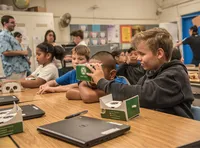Exploring the significance of Pearl Harbor with Google Expeditions

Editor’s Note: Today’s guest author is Michael Fricano II, an Education Architect at The Janus Group. As a longtime educator and resident of Hawaii, Michael shares his experience of teaching students about Pearl Harbor with Google Expeditions.
Many students learn about World War II and the attack on Pearl Harbor by reading facts and figures from a history book, but today teachers are using technology to provide a richer understanding of Hawaii’s vital role in World War II. Having lived in Hawaii for many years, I’ll always hold Pearl Harbor and December 7th in a special place in my heart. This year, I’m particularly inspired to hear how teachers are using technology to explain the cultural and political significance of the Japanese attack.
To honor the 75th anniversary of the attack on Pearl Harbor, Ms. Marielle Beaudet, a fifth grade teacher at Pearl Harbor Elementary School, used one of our lesson plans that integrates Google Expeditions to show students important locations on Oahu, from the naval base to Punchbowl Cemetery to the USS Bowfin. Many students had already visited these places in person but hadn’t learned about their historical significance.
As students virtually stood on top of Diamond Head overlooking the Pacific Ocean, they saw the 360 degree view that made it a vital defensive bunker, called Fort Ruger. One student commented, “I had no idea there was a bunker at the top of Diamond Head!” Another student said, “You can see all over the island from up here!” realizing why it was such an important location.
![[edu] pearlharbor2 cropped.png](https://storage.googleapis.com/gweb-uniblog-publish-prod/images/pearlharbor2_cropped.width-100.format-webp.webp)
Students explored inside one of the most famous American submarines from the war, USS Bowfin, using Google Expeditions to see the Torpedo Room, Control Room and the Galley. Using a lesson that incorporates different G Suite tools, students brainstormed questions they would want to ask a sailor aboard the submarine. This type of virtual reality experience encouraged students to think about day-to-day life aboard a submarine and made them curious about the sailors’ food, sleeping conditions and leisure activities. One student, who noticed a bed above one of the torpedos, yelled out, “I wouldn’t want to sleep on top of those. You’d have to be really brave!” Reading about the submarine is fascinating, but showing students the space helps paint a clearer picture of how sailors lived leading up to the attack on Pearl Harbor.
Visiting these historical locations through Expeditions gave students a stronger connection to their homeland and sparked new curiosity about the places they pass every day. I was moved when I heard one student say, “[National Pearl Harbor Remembrance Day] is meant for us to show our appreciation to those that fought for us. We have to show our respect and never forget what happened.”
If you want to bring this experience to your class, check out one of the many Expeditions featuring Pearl Harbor — The Battleship USS Missouri, Onboard the USS Bowfin Submarine, World War II, and Pearl Harbor and Hawaii During World War II. To get started with Expeditions download the free app for iOS or Android, or look into Google Expeditions Kits.






